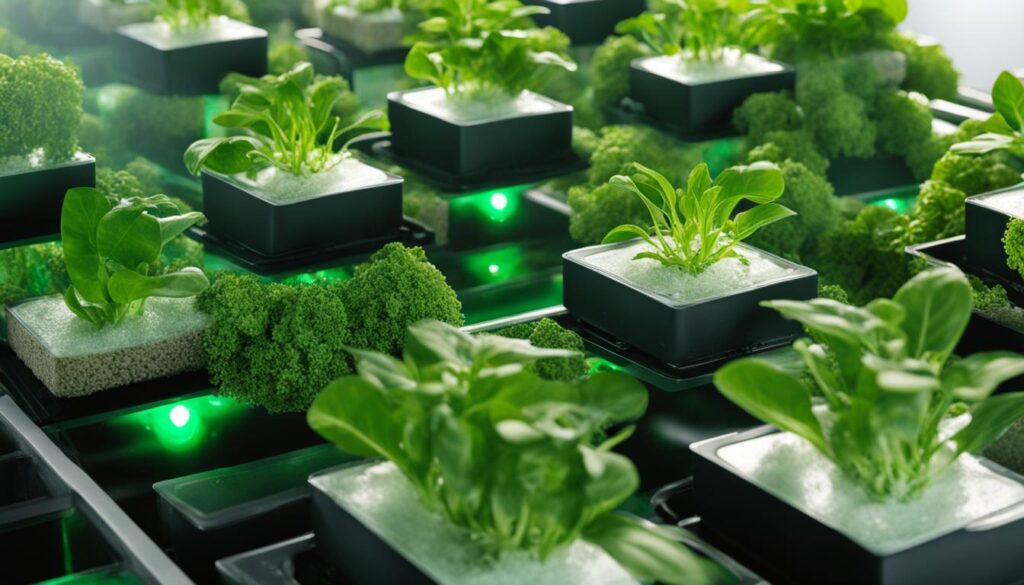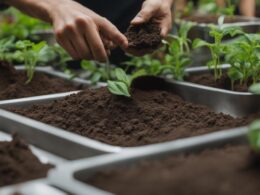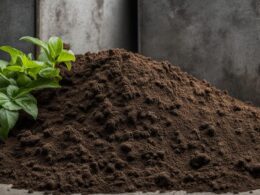In the world of hydroponics, finding sustainable hydroponic substrates is crucial for the long-term success of your garden. As awareness around environmental sustainability increases, more and more growers are considering Rockwool alternatives in hydroponics that can help lessen their ecological footprint. This article explores some of the different eco-friendly hydroponic media available that prioritize both plant growth and the environment.
Switching to renewable hydroponic growing mediums not only supports a healthier ecosystem but can also potentially enhance growth efficiency. By investigating a variety of Rockwool alternatives that cater to different system needs, plant types, and personal preferences, gardeners and commercial growers alike can contribute to a more sustainable approach to hydroponic farming.
Key Takeaways
- Transition to sustainable substrates for enhanced hydroponic growth efficiency.
- Consider a variety of Rockwool alternatives, each with unique properties and benefits.
- Opt for eco-friendly options like coco coir, perlite, vermiculite, and expanded clay pellets.
- Choose alternatives that also address environmental concerns associated with Rockwool disposal.
- Embrace renewable and biodegradable media for more responsible and sustainable hydroponic practices.
Understanding Hydroponics and the Role of Rockwool
Hydroponic growing systems, in which plants are grown in a soilless medium, have gained popularity due to their efficient use of resources and ability to provide year-round produce. In these systems, plants rely on nutrient-rich water to nourish their roots, leading to accelerated growth rates compared to traditional soil-based methods. One medium that has been heavily utilized in hydroponic cultivation is Rockwool, due to its versatility and excellent water retention properties.
Rockwool, a fibrous growing medium, offers a range of benefits for soilless plant growth, such as optimal air-to-water ratio and efficient nutrient delivery. Its diverse forms – including cubes, slabs, and granules – have made it adaptable for different plant sizes and system configurations, aligning with the needs of various hydroponic setups. However, given the environmental concerns surrounding Rockwool use, it is crucial to understand the broad spectrum of available media that can achieve similar or better results in hydroponic agriculture.
- The importance of finding a suitable growing medium: In hydroponic systems, the right growing media is essential for maintaining plant stability and facilitating nutrient and water uptake. However, the choice of medium should also take environmental considerations into account.
- Characteristics of Rockwool: Rockwool offers excellent water retention capabilities and efficient nutrient delivery, making it a go-to choice for hydroponic gardeners. However, its non-biodegradable nature raises environmental concerns.
| Characteristics | Rockwool | Eco-friendly Alternatives |
|---|---|---|
| Water retention | High | Varies depending on alternative |
| Nutrient delivery | Highly efficient | Comparable efficiency with the right choice of media |
| Environmental impact | Non-biodegradable, landfill waste | Renewable, biodegradable options available |
While Rockwool has been a staple in hydroponic nutrient solutions due to its various advantages, it is essential to explore alternative growing media that meet the needs of different setups without compromising the environment. By investigating and adopting eco-friendly mediums, hydroponic growers can contribute to a more sustainable and environmentally conscious approach to agriculture.
Environmental Impacts: The Need for Greener Growing Media
The use of Rockwool in hydroponics presents significant long-term environmental challenges. The material is non-biodegradable, which means it accumulates in landfills for centuries, causing a severe problem with Rockwool waste. Furthermore, Rockwool production is energy-intensive, which further exacerbates its environmental impact. As a result, the hydroponics industry and individual growers alike are seeking alternative sustainable growing media that minimize ecological footprints.
Challenges with Rockwool Disposal
One of the major concerns associated with Rockwool is its disposal. Since it is a non-biodegradable material, it does not break down naturally in the environment. This leads to the accumulation of Rockwool waste in landfills, where it can persist for hundreds of years, causing environmental damage and occupying valuable space that could be allocated to more sustainable waste management practices.
Moreover, the energy-intensive production process of Rockwool contributes to greenhouse gas emissions and resource depletion, further increasing its environmental impact. This raises concerns regarding the sustainability of Rockwool as a growing medium in the ever-expanding hydroponics industry.
Eco-friendly Solutions in Hydroponics
As awareness of the environmental impact of Rockwoil grows, hydroponics practitioners are turning to eco-friendly alternatives to address the issues associated with Rockwool. Sustainable growing media such as coconut fiber (coco coir), perlite, and clay pellets provide an opportunity to maintain plant health and productivity while improving the environmental profile of hydroponic operations.
These alternatives offer several benefits over Rockwool, including:
- Biodegradability, reducing waste accumulation in landfills
- Renewability, with many sourced from byproducts of other industries
- Lower energy requirements for production, curtailing greenhouse gas emissions
By adopting these eco-friendly hydroponic mediums, both commercial and home growers can significantly reduce their ecological footprint while promoting healthier and more sustainable plant growth. The widespread availability of these sustainable hydroponic substrates facilitates their integration into a broad range of hydroponic systems, paving the way for a greener future in soilless agriculture.
Coco Coir: A Renewable and Versatile Medium
One of the most popular alternatives to traditional hydroponic media is coco coir. Derived from the fibrous husks of coconuts, coco coir boasts several advantages as a renewable and multi-functional hydroponic medium. Given its exceptional ability to retain moisture and support proper aeration, it promotes healthy root development in sustainable gardening practices. Thanks to its sustainability and biodegradability, coco coir effectively addresses the environmental concerns associated with traditional hydroponic media.
Coco coir comes in various forms, providing versatile solutions for different hydroponic applications:
- Coco peat: A fine, granulated form of coco coir that is well-suited for seedlings, and often mixed with other media.
- Coco chips: Larger chunks of coco coir that improve drainage in hydroponic systems, and are often utilized in blends.
- Coco slabs: Compressed rectangular blocks that can be used in larger hydroponic setups.
Beyond its versatility, coco coir offers several benefits as a coconut fiber medium for hydroponics:
- High water retention capacity: Coco coir can hold up to 10 times its weight in water, ensuring that plant roots don’t dry out.
- Excellent aeration: The structure of coco coir prevents compaction, maintaining optimal aeration for root health.
- Neutral pH: Coco coir has a balanced pH level, allowing plants to absorb nutrients efficiently without the need for adjustments.
- Natural pest and disease resistance: Coco coir contains compounds that deter pests and fungal growth, boosting plant health and reducing the need for pesticides.
| Type of Coco Coir | Benefits | Best Suited for |
|---|---|---|
| Coco Peat | Finely granulated form, excellent water retention | Seedlings, mixed media, and drip irrigation systems |
| Coco Chips | Improved drainage, suitable for larger systems | Blends with other media, ebb and flow systems |
| Coco Slabs | Compressed blocks, ideal for larger setups | Flood and drain systems, NFT systems |
Overall, incorporating coco coir in hydroponics is an excellent way to embrace renewable plant substrates and promote a more sustainable approach to soilless agriculture. By opting for coco coir and other environmentally friendly alternatives, hydroponic farmers can support healthier ecosystems while fostering efficient plant growth and yielding impressive results.
Perlite and Vermiculite: Lightweight Options for Hydroponic Systems
Perlite and vermiculite are two eco-friendly alternatives to conventional hydroponic media like Rockwool. These lightweight mediums offer excellent benefits to hydroponic growers, such as improved oxygenation in plant roots, natural pH regulation, and low environmental impact.
The Benefits of Perlite in Hydroponics
Perlite in hydroponics has gained popularity due to its unique characteristics. Derived from volcanic rock, it is a lightweight hydroponic medium that offers excellent aeration and prevents overwatering issues. Perlite’s natural pH balance reduces the chances of nutrient lockout, promoting optimal nutrient uptake.
- High oxygenation levels promote healthy root growth and prevent root rot.
- Natural pH regulation makes it easier to maintain the desired acidity level of the nutrient solution.
- Wicking properties allow perlite to work well in wick-based hydroponic systems.
- Perlite’s lightweight nature reduces the overall weight of the system, making it easier to manage and maintain.
Vermiculite’s Superior Water Retention Abilities
Vermiculite in hydroponics is known for its exceptional water retention capabilities. Produced through the expansion of the mineral mica, it works synergistically with other mediums, such as perlite and coco coir, to create superior hydroponic blends that offer moisture control and drainage, vital for optimal root health and efficient nutrient uptake.
| Perlite | Vermiculite | |
|---|---|---|
| Key Benefits | High Air Retention, Excellent Drainage, pH Regulation | Superior Water Retention, Soilless Moisture Control, Enhanced Nutrient Uptake |
| Common Hydroponic Applications | Wick Systems, Nutrient Film Technique (NFT), Flood and Drain Systems | Flood and Drain Systems, Drip Systems, Seed Starting Mixtures |
| Sustainability Factors | Non-toxic, Chemically Inert, Renewable Material | Non-toxic, Sterile, Sustainable Resource |
By utilizing perlite and vermiculite in hydroponic systems, growers can benefit from their unique properties while also contributing to an eco-friendlier approach to soilless agriculture. Making the switch to these lightweight and sustainable alternatives not only supports crop health and growth but also aids in minimizing the environmental impact of hydroponic farming.
Expanded Clay Pellets and Growstones: Reusable and Efficient
Expanded clay pellets and Growstones are two reusable hydroponic media options that provide efficient growing substrates for hydroponic systems. Both man-made mediums are known for their excellent drainage and reusability, ensuring a cost-effective and environmentally friendly choice for gardeners and commercial growers alike.
Their unique structure aids in water management and nutrient delivery while maintaining the necessary aeration for robust plant growth. In this section, we’ll discuss the properties and advantages of expanded clay pellets in hydroponics and Growstones.
Expanded Clay Pellets: A Versatile Hydroponic Medium
Expanded clay pellets are made by heating clay to a high temperature, causing it to expand and become porous. This lightweight, spherical medium with a hard outer shell is widely used in hydroponics due to its desirable properties, including:
- Improved oxygenation for root growth
- Effective water retention and drainage to prevent overwatering
- Neutral pH for balanced nutrient delivery
- Reusable after proper sterilization
This combination of features makes expanded clay pellets an efficient growing substrate that contributes to well-rounded plant development throughout the lifecycle.
Growstones: An Eco-friendly Alternative to Traditional Hydroponic Media
Growstones are a sustainable alternative to traditional hydroponic media, produced using recycled glass and high heat. The resulting lightweight medium offers several benefits, including:
- Highly effective aeration and root zone oxygenation
- Superior water retention and drainage
- Resistance to mold and algae growth
- Reusable after proper cleaning and sterilization
Growstones offer an eco-friendly and efficient growing substrate for hydroponic gardeners seeking a reusable, high-performance medium.
| Hydroponic medium | Aeration | Drainage | Reusability |
|---|---|---|---|
| Expanded Clay Pellets | High | Excellent | Yes, after sterilization |
| Growstones | High | Superior | Yes, after cleaning and sterilization |
Both expanded clay pellets and Growstones are excellent choices for reusable hydroponic media in various growing systems. Their unique properties provide efficient growing substrates, promoting healthier plant growth. Choosing one of these environmentally friendly and reusable options will not only reduce waste but also contribute to more sustainable hydroponic farming practices.
Sustainable Biomass Options: Rice Hulls and Sawdust
As the demand for eco-friendly hydroponic media continues to grow, sustainable biomass options such as rice hulls and sawdust present viable alternatives to conventional substrates. Both rice hulls and sawdust offer unique advantages as organic growing mediums, stemming from their availability, nutrient capacity, and ability to improve overall plant health.
Advantages of Using Rice Hulls in Hydroponics
Rice hulls, a byproduct of rice production, are gaining prominence as a sustainable biomass choice for hydroponic systems. With their excellent drainage and water absorption properties, rice hulls provide an ideal environment for plant roots to thrive. Some key benefits of using rice hulls in hydroponics are:
- High nutrient capacity: Rice hulls contain substantial amounts of essential micronutrients and minerals, facilitating the uptake of these nutrients by the plant roots and contributing to healthier plant growth.
- Improved drainage: The lightweight and porous structure of rice hulls ensures optimal drainage and aeration, which are critical for preventing root rot and maintaining the desired moisture levels for plants.
- Reduced salt buildup: Rice hulls effectively minimize the accumulation of excess salts in the growing medium, reducing the risk of nutrient lockout and salt toxicity.
- Eco-friendly: With rice hulls being a naturally occurring byproduct of rice milling, their use as a growing medium contributes to recycling agricultural waste and promoting sustainable hydroponics practices.
Another promising biomass option for hydroponics is sawdust, a byproduct of wood processing. Sawdust shares some benefits of rice hulls as a growing medium, such as the ability to retain moisture and its eco-friendliness. Despite its potential advantages, it’s essential to consider local regulations and guidelines when using sawdust in hydroponic systems, as it may require additional processing or treatment.
Ultimately, selecting suitable organic growing mediums like rice hulls or sawdust in hydroponic systems may help create a sustainable and thriving environment for your plants. By exploring various biomass alternatives, you can contribute to reducing the environmental impact of hydroponic systems and promote the adoption of sustainable hydroponic practices.
What Are Some Sustainable Substrates for Plant Growth Other Than Rockwool?
When considering sustainable substrates for plant growth, it’s important to explore options beyond rockwool. Oasis cubes offer a more eco-friendly alternative, providing a similar environment for plant roots to thrive. In an oasis cubes rockwool comparison, the former emerges as a viable and sustainable choice for conscientious growers.
Conclusion
In the quest for hydroponic sustainability, alternative growing media have emerged as essential components in soilless agriculture. By utilizing eco-friendly hydroponic substrates, gardeners and commercial growers can maintain optimal plant growth while actively adopting eco-conscious hydroponic practices. A selection of diverse and renewable materials provides plenty of options for those looking to make the switch from Rockwool and champion a greener future in hydroponics.
Whether it’s the renewable and versatile nature of coco coir, the lightweight properties of perlite and vermiculite, or the reusable and efficient characteristics of expanded clay pellets and Growstones, the range of alternatives offers solutions for different hydroponic systems and plant needs. Sustainable biomass options such as rice hulls and sawdust also contribute to minimizing the environmental concerns associated with traditional growing media like Rockwool, addressing issues of waste disposal and production resources.
By embracing these eco-friendly alternatives, hydroponic practitioners can ensure the health and success of their plants without compromising our planet’s well-being. As more and more people recognize the importance of sustainable practices in soilless agriculture, the future of hydroponics appears increasingly promising, paving the way for environmentally responsible and effective growing systems across the globe.












